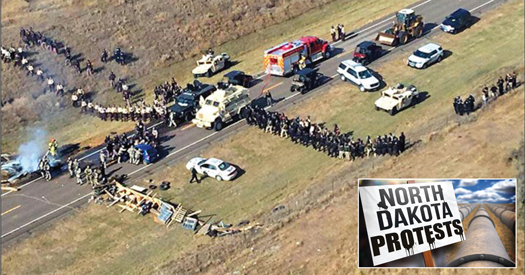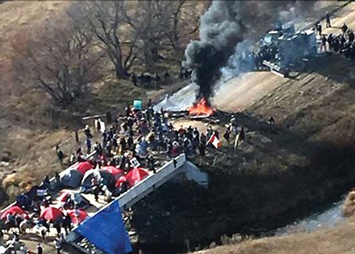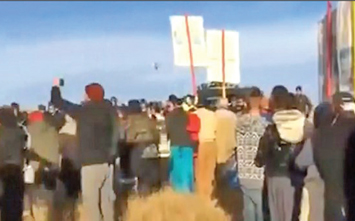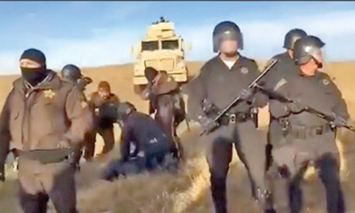Resistance continues at Standing Rock
By Starla Muhammad -Managing Editor- | Last updated: Nov 3, 2016 - 12:16:05 PMWhat's your opinion on this article?

Scene above 1806 in Morton County, protesters and police officers in conflict over pipeline, Oct. 27.
|
Despite several days of unrest which included arrests by law enforcement of over 100 demonstrators known as “water protectors” at Standing Rock, those camped out in tents and teepees with supporters continue their resolve and efforts to protect land and water from construction of the Dakota Access Oil Pipeline (DAPL).

|
According to several reports, there have been claims of excessive force by law enforcement and abusive treatment in jails of those arrested. However, demonstrations continue with activists stating they will continue camping out near the proposed pipeline site until the project is permanently halted. Local police as well as the National Guard and police from several other states have been deployed to the area.
According to the UK-based publication the Guardian, native leaders camped out in the cold there said they have grown increasingly concerned that time is running out to stop the project on the ground. Pipeline workers, they say, are getting frighteningly close to the sacred water of the Missouri river.

Protesters and police officers stand-off at the Dakota access pipeline, Oct. 27.
|
Energy Transfer Partners insists the project is safe. The tribe is fighting the pipeline’s permitting process in federal court.
The Standing Rock Sioux, whose reservation straddles the North Dakota-South Dakota border, are suing federal regulators for approving the oil pipeline. They have challenged the U.S. Army Corps of Engineers decision to grant permits at more than 200 water crossings and argue that the pipeline would be placed less than a mile upstream of the reservation, potentially affecting drinking water for more than 8,000 tribal members and millions downstream. The tribe alleges they were not adequately consulted on the project until after construction started.
A federal judge in September denied their request to block construction of the entire pipeline. Three federal agencies stepped in and ordered a temporary halt to construction on corps land around and underneath Lake Oahe—one of six reservoirs on the Missouri River.
The corps is reviewing its permitting of the project and has given no timetable for a decision. Meanwhile, the tribe’s appeal is still pending in federal court. In the meantime, protests continue even as winter and cold temperatures are on the horizon.

Protesters at the Dakota access pipeline. Photo and Graphics: MGN Online
|
“The demonstrations, which have grown into a national symbol of indigenous rights and climate change activism, have resulted in more than 400 arrests, with local law enforcement accusing Native American activists, journalists and filmmakers of rioting, trespassing, resisting arrest and a number of other serious felony charges,” the Guardian reported.
Tensions grew Oct. 27 when police began physically and by force, removing demonstrators.
Standing Rock Sioux Chairman Dave Archambault called the action “violence against innocent, prayerful people.” He has also called for a re-routing of the pipeline, reported The Associated Press.
Video footage which has gone viral, shows the presence of military tanks and law enforcement donning combat gear and militarized weaponry face to face with unarmed protestors, who prefer to be known as “water protectors.” In one video, law enforcement officers appear to use pepper spray on demonstrators.

Police in riot gear move in to clear demonstrators for the Dakota access pipeline, Oct. 27. Photo and Graphics: MGN Online
|
Groups and organizations around the country have held protests in solidarity with the Sioux nation in opposition to the pipeline. Alaskan Natives and others held protests in Anchorage on Oct. 30. A FaceBook page titled, “Chicago in Solidarity with Standing Rock is planning a series of rallies and events.
Amnesty International USA recently sent a delegation of human rights observers to monitor events on the ground. “AIUSA also has sent a letter to the Morton County Sheriff’s Department expressing concern about the degree of force used against the protests. The organization will also call on the Department of Justice to investigate police practices,” notes the group’s website.
Social media hashtags #BoycottDAPL, #NoDAPL, #StandingRock and others have increased awareness of what is happening and is shining a spotlight on the issue as the standoff continues.
Native American and Indigenous people from the U.S. and abroad have traveled to Standing Rock to show their support. Celebrities and others have also joined the fight. Actors Mark Ruffalo, Rosario Dawson, Shailene Woodley and music producer Pharrell Williams have taken to social media or visited Standing Rock to show support and solidarity.

Susana Sandoval
|
Ms. Sandoval said she did not see any weapons by people in the camps and that the spirit among the men, women and children is one of continuing the fight for their sovereignty and rights. People are not allowed into the camps if they have weapons or alcohol, she said. There are three camps set up and people have established a community there which includes a school, said Ms. Sandoval.Many of the elders she spoke to said what was happening was reminiscent of historical moments in Native American and Indigenous history such as the Wounded Knee massacre when U.S. troops slaughtered dozens of Indian men, women and children in 1890.
“We’re being escorted by tribal elders and they’re being told that they’re not allowed to move freely on their own land. That is a deliberate intent to destroy a people’s spirit,” said Ms. Sandoval who has since returned to Standing Rock.
Yonasda Lonewolf, daughter of the late Oglala Lakota activist Wauneta Lonewolf of Pine Ridge, South Dakota, along with other indigenous activists and allies are working to do their part to bring more national and inter-national awareness to what is happening and what it portends for various Native American nations and their rights of sovereignty.
Ms. Lonewolf and others are spearheading a MNI Wiconi Benefit Concert and Roundtable Discussion on Nov. 25 and 26 in Standing Rock which will also be livestreamed. Proceeds from the concert, noted organizers will be donated to the #NODAPL Legal Fund. She and many activists are calling for a boycott of the multimillion dollar corporations funding the pipeline. In an interview on Democracy Now, Hugh MacMillian of Food and Water Watch stated at least 17 banks were providing funding for the project.
“Citibank is the bank that’s been running the books on the project, and that’s the bank that beat the bushes and got other banks to join in. So, we have Wells Fargo, BNP Paribas, SunTrust, Royal Bank of Scotland, Bank of Tokyo-Mitsubishi, Mizuho Bank, TD Securities, ABN AMRO Capital, DNB First Bank—and that’s actually a bank based in Philly; it’s not the DNB Bank based in Norway, which is actually provided several hundred million to the Energy Transfer family separately—and ICBC London, SMBC Nikko Securities and Société Générale,” said Mr. MacMillian during the Sept. 9 interview.
“Since the government wants to continue breaking our treaties let’s redistribute the pain by closing our accounts and putting our money in community credit unions or local small banks,” said Ms. Lonewolf via her FaceBook page.
For more information visit standingrock.org. For more information about the roundtable discussion and concert contact Yonasda Lonewolf at [email protected] or Waste. Win Young at [email protected].
(The Associated Press contributed to this report.)
INSIDE STORIES AND REVIEWS
-
-
About Harriett ... and the Negro Hollywood Road Show
By Rabiah Muhammad, Guest Columnist » Full Story -
Skepticism greets Jay-Z, NFL talk of inspiring change
By Bryan 18X Crawford and Richard B. Muhammad The Final Call Newspaper @TheFinalCall » Full Story -
The painful problem of Black girls and suicide
By Charlene Muhammad -National Correspondent- » Full Story -
Exploitation of Innocence - Report: Perceptions, policies hurting Black girls
By Charlene Muhammad -National Correspondent- » Full Story -
Big Ballin: Big ideas fuel a father’s Big Baller Brand and brash business sense
By Bryan Crawford -Contributing Writer- » Full Story






 Click Here Stay Connected!
Click Here Stay Connected!








